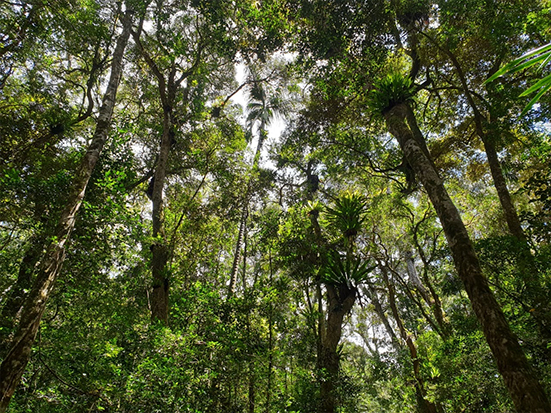We have got to up our game substantially for forests, carbon, biodiversity, and ultimately people
Keywords:
forests, climate change, biodiversity, UNFCCC, IPCC, restoration, reforestation, deforestation, déforestation, point de rupture, changement climatique, restaurationAbstract
A recently published contribution in Nature by Lenton et al. (2019) shows that Earth is risking an irreversible planetary tipping point. This means that the Earth’s climate system is in a state of emergency, rushing its way towards a point of no return. The authors have identified nine tipping points—inter alia—melting Arctic and Antarctic ice sheets, retreating permafrost, changing boreal forest fire and pest regimes, and increased frequency of droughts in the Amazon forest. These signals are raising global concerns. While science expected these tipping points to be reached at 3°C increase (e.g., Lemoine and Traeger 2016), recent trends are corroborating the hypothesis that these points of irreversible and abrupt system change already show high probability of being reached within the bounds of 1.5–2°C. During the COP21 of the United Nation Framework Convention for Climate Change (UNFCCC), 195 countries adopted the Paris Agreement to limit global temperature rise to well below 2°C.
References
Barlow, J., Berenguer, E., Carmenta, R. and França, F. 2019. Clarifying Amazonia's burning crisis. Global Change Biology. <https://doi.org/10.1111/gcb.14872>
Crowther, T. W., Glick, H. B., Covey, K. R., Bettigole, C., Maynard, D. S., et al. 2015. Mapping tree density at a global scale. Nature 525: 201–205. <https://doi.org/10.1038/nature14967>
Curtis, P. G., Slay, C. M., Harris, N. L., Tyukavina, A., & Hansen, M. C. 2018. Classifying drivers of global forest loss. Science 361, 6407: 1108–1111. <https://doi.org/10.1126/science.aau3445>
Dinerstein, E., Vynne, C., Sala, E., Joshi, A. R., Fernando, S., et al. 2019. A global deal for nature: guiding principles, milestones, and targets. Science Advances 5, 4: eaaw2869. <https://doi.org/10.1126/sciadv.aaw2869>
Gardner, C. J. and Wordley, C. F. 2019. Scientists must act on our own warnings to humanity. Nature Ecology & Evolution 3, 9: 1271–1272. <https://doi.org/10.1038/s41559-019-0979-y>
Gaveau, D. L., Locatelli, B., Salim, M. A., Yaen, H., Pacheco, P. and Sheil, D. 2018. Rise and fall of forest loss and industrial plantations in Borneo (2000–2017). Conservation Letters 12, 3: e12622. <https://doi.org/10.1111/conl.12622>
Hockley, N., Mandimbiniaina, R. and Rakotonarivo, O. S. 2018. Fair and equitable conservation: do we really want it, and if so, do we know how to achieve it? Madagascar Conservation & Development 13, 1: 3–5. <https://doi.org/10.4314/mcd.v13i1.11>
Klanderud, K., Mbolatiana, H. Z. H., Vololomboahangy, M. N., Radimbison, M. A., Roger, E., et al. 2010. Recovery of plant species richness and composition after slash-and-burn agriculture in a tropical rainforest in Madagascar. Biodiversity and Conservation 19, 1: 187–204. <https://doi.org/10.1007/s10531-009-9714-3>
Lemoine, D. and Traeger, C. P. 2016. Economics of tipping the climate dominoes. Nature Climate Change 6, 5: 514–519. <https://doi.org/10.1038/nclimate2902>
Lenton, T. M., Rockström, J., Gaffney, O., Rahmstorf, S., Richardson, K., et al. 2019. Climate tipping points—too risky to bet against. Nature 575: 592–595. <https://doi.org/10.1038/d41586-019-03595-0>
Lovejoy, T. E. and Nobre, C. 2018. Amazon tipping point. Science Advances 4, 2: eaat2340. <https://doi.org/10.1126/sciadv.aat2340>
Mongabay. 2019. Worldwide deforestation rising despite bold commitments, report finds. Available online <https://news.mongabay.com/2019/09/worldwide-deforestation-rising-despite-bold-commitments-report-finds/>
NYDF Assessment Partners. 2019. Protecting and Restoring Forests: A Story of Large Commitments yet Limited Progress. New York Declaration on Forests Five-Year Assessment Report. Climate Focus (coordinator and editor). Available online <https://forestdeclaration.org/images/uploads/resource/2019NYDFReport.pdf>
Pancel, L. and Köhl, M. 2016. Tropical Forestry Handbook. Springer Berlin Heidelberg 4 vol.: i–lx,1–3633. <https://doi.org/10.1007/978-3-642-41554-8>
Ranjatson, P., McLain, R., Mananga, J., Randrianasolo, R., Razafimbelo, Ny T., Lawry, S. 2019. Tenure Security and Forest Landscape Restoration: Results from Exploratory Results from Explanatory Research in Boeny, Madagascar. Paper prepared for presentation at the“2019 World Bank Conference On Land And Poverty”. The World Bank, Washington DC. Available online <http://www.cifor.org/publications/pdf_files/Papers/PMcLain1901.pdf>
Styger, E., Rakotondramasy, H. M., Pfeffer, M. J., Fernandes, E. C. andBates, D. M. 2007. Influence of slash-and-burn farming practices on fallow succession and land degradation in the rainforest region of Madagascar. Agriculture, Ecosystems & Environment 119(3–4): 257–269. <https://doi.org/10.1016/j.agee.2006.07.012>
Tollefson, J. 2019. Humans are driving one million species to extinction. Nature 569: 171. <https://doi.org/10.1038/d41586-019-01448-4>
Turubanova, S., Potapov, P. V., Tyukavina, A. and Hansen, M. C. 2018. Ongoing primary forest loss in Brazil, Democratic Republic of the Congo, and Indonesia. Environmental Research Letters 13, 7: 074028. <https://doi.org/10.1088/1748-9326/aacd1c>
Tyukavina, A., Hansen, M. C., Potapov, P., Parker, D., Okpa, C., Stehman, S. V., et al. 2018. Congo Basin forest loss dominated by increasing smallholder clearing. Science Advances 4, 11: eaat2993. <https://doi.org/10.1126/sciadv.aat2993>
Waeber, P. O., Rafanoharana, S., Rasamuel, H. A. and Wilmé, L. 2019. Parks and reserves in Madagascar: managing biodiversity for a sustainable future. [Online First], IntechOpen. <https://doi.org/10.5772/intechopen.85348>

Downloads
Published
Issue
Section
License
All journal content, except where otherwise noted, is licensed under a creative common Attribution 4.0 International and is published here by the Indian Ocean e-Ink under license from the author(s).


